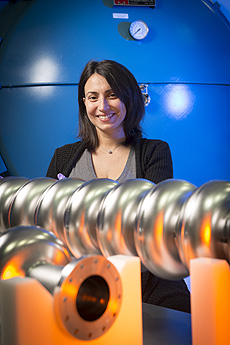Anna Grassellino receives $2.5 million DOE award for research on SRF cavities
 |
Anna Grassellino's Early Career Research Award-winning work enables the efficient, cost-effective acceleration of particle beams. Photo: Reidar Hahn |
Thanks to science, we get more for less. We get more features on a newer car model, more data and information stored on a computer, and all for the same or lowered cost.
That same principle applies to accelerator R&D, where improving the performance and lowering the cost can help open doors to new ideas.
The Department of Energy recently named Fermilab physicist and 2013 Peoples Fellow Anna Grassellino as a recipient of the prestigious Early Career Research Award for her work to develop particle accelerator cavities that have improved performance and are less expensive to operate.
The $2.5 million award, spread out over five years, will fund Grassellino's research to expand her recent discovery of the cavity surface doping effect to a wide range of applications. The research will lead to enabling technologies for future superconducting accelerators used for a broad spectrum of scientific machines, medical uses, and nuclear energy applications.
"This grant is extremely important, as it will allow me to expand our current findings and do further exploratory research that isn't always possible, as often we focus on development work that is project-targeted," Grassellino said. "But the big technological breakthroughs, which then enable new machines, are made by trying something completely new and by pursuing the fundamental understanding of the mechanisms in play. This is the exciting part of this grant — there may be more breakthroughs coming."
SRF cavities enable acceleration of beams of particles. These innermost components of an accelerator are strung together, like a strand of pearls, inside a vessel called a cryomodule, which keeps them at very cold temperatures.
To get the best performance, scientists treat a very thin layer of the cavity surface, measuring several tenths of nanometers. Traditionally, researchers believed that these cavities should be made from very pure niobium, but Grassellino discovered that the addition of a little bit of impurity, such as nitrogen gas, into the niobium surface can help to greatly increase the cavity efficiency.
By doping the niobium surface of a 1.3-gigahertz, single-cell cavity with an impurity such as nitrogen gas, Grassellino and the Fermilab SRF team increased the cavity's quality factor, or Q, the measure of how well the cavity stores energy, to previously unseen values. During recent tests, she measured a world-record value for Q, which was almost three to four times that of the next-highest reported quality factor of any accelerator cavity.
Since many particle accelerators and physics experiments require a great deal of power, more efficient cavities will bring down the cost of refrigeration, often the most expensive part of running an experiment.
The new technique can substantially lower the cost of operating high-energy particle accelerators. It can also make possible machines that use a lot of power, such as a future light source or continuous-wave beam experiments, that would otherwise be cost-prohibitive.
"We made this discovery two years ago, and it has already turned into the enabling technology for important future machines. We are very excited," Grassellino said. "This shows how this type of funding eventually pays huge dividends from unexpected discoveries and applications."
She says the next steps are to deepen the understanding of why the technique works and to explore other options.
"This award gives me the chance to extend the technique to cavities of different frequencies, to try other gases, to understand the new surface nanostructure," Grassellino said. "Most importantly, it will allow us to advance SRF science and gain new knowledge, which is power, even if the implications are not fully understood at the time of the discovery."
Hasan Padamsee, head of Fermilab's Technical Division, is a world-renowned expert in SRF technology. He finds her work intriguing.
"Now it is just a question of translating that to large-scale structures, such as cryomodules," he said.
This is the second DOE Early Career Research Award for SRF researchers in Fermilab's Technical Division in recent years. It will support Grassellino and two students and will provide funding for materials, testing and processing.
"To have good quality researchers as part of the division is an important leg for the division to stand on," Padamsee said.
—Rhianna Wisniewski
|